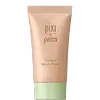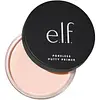What's inside
What's inside
 Key Ingredients
Key Ingredients

 Benefits
Benefits

 Concerns
Concerns

 Ingredients Side-by-side
Ingredients Side-by-side

Water
Skin ConditioningCetyl Ethylhexanoate
EmollientGlycerin
HumectantEthylhexyl Methoxycinnamate
UV AbsorberSynthetic Fluorphlogopite
Mica
Cosmetic ColorantCetearyl Alcohol
EmollientGlyceryl Stearate
EmollientPEG-100 Stearate
Sorbitan Stearate
EmulsifyingSorbitan Sesquioleate
EmulsifyingPhenoxyethanol
PreservativeAmmonium Acryloyldimethyltaurate/Vp Copolymer
Panthenol
Skin ConditioningHydroxyethyl Acrylate/Sodium Acryloyldimethyl Taurate Copolymer
Emulsion StabilisingHydrogenated Polydecene
EmollientDisodium EDTA
Polysorbate 80
EmulsifyingTin Oxide
AbrasiveTocopheryl Acetate
AntioxidantAscorbic Acid
Antioxidant1,2-Hexanediol
Skin ConditioningRetinyl Palmitate
Skin ConditioningSodium Hyaluronate
HumectantTocopherol
AntioxidantTitanium Dioxide
Cosmetic ColorantIron Oxides
Water, Cetyl Ethylhexanoate, Glycerin, Ethylhexyl Methoxycinnamate, Synthetic Fluorphlogopite, Mica, Cetearyl Alcohol, Glyceryl Stearate, PEG-100 Stearate, Sorbitan Stearate, Sorbitan Sesquioleate, Phenoxyethanol, Ammonium Acryloyldimethyltaurate/Vp Copolymer, Panthenol, Hydroxyethyl Acrylate/Sodium Acryloyldimethyl Taurate Copolymer, Hydrogenated Polydecene, Disodium EDTA, Polysorbate 80, Tin Oxide, Tocopheryl Acetate, Ascorbic Acid, 1,2-Hexanediol, Retinyl Palmitate, Sodium Hyaluronate, Tocopherol, Titanium Dioxide, Iron Oxides
Water
Skin ConditioningCyclopentasiloxane
EmollientCeresin
Emulsion StabilisingDimethicone
EmollientGlycerin
HumectantHydrogenated Polyisobutene
EmollientHdi/Trimethylol Hexyllactone Crosspolymer
Polymethylsilsesquioxane
Trimethylsiloxysilicate
EmollientPropylene Glycol
HumectantLauryl PEG-10 Tris(Trimethylsiloxy)Silylethyl Dimethicone
EmulsifyingSodium Chloride
MaskingCamellia Sinensis Leaf Extract
AntimicrobialSqualane
EmollientOryza Sativa Bran Wax
Skin ConditioningDimethicone/PEG-10/15 Crosspolymer
Dimethicone Crosspolymer
Emulsion StabilisingSilica
AbrasiveTriethoxycaprylylsilane
Talc
AbrasiveButylene Glycol
HumectantDisodium EDTA
Caprylyl Glycol
EmollientEthylhexylglycerin
Skin ConditioningPhenoxyethanol
PreservativeCI 77891
Cosmetic ColorantIron Oxides
Water, Cyclopentasiloxane, Ceresin, Dimethicone, Glycerin, Hydrogenated Polyisobutene, Hdi/Trimethylol Hexyllactone Crosspolymer, Polymethylsilsesquioxane, Trimethylsiloxysilicate, Propylene Glycol, Lauryl PEG-10 Tris(Trimethylsiloxy)Silylethyl Dimethicone, Sodium Chloride, Camellia Sinensis Leaf Extract, Squalane, Oryza Sativa Bran Wax, Dimethicone/PEG-10/15 Crosspolymer, Dimethicone Crosspolymer, Silica, Triethoxycaprylylsilane, Talc, Butylene Glycol, Disodium EDTA, Caprylyl Glycol, Ethylhexylglycerin, Phenoxyethanol, CI 77891, Iron Oxides
 Reviews
Reviews

Ingredients Explained
These ingredients are found in both products.
Ingredients higher up in an ingredient list are typically present in a larger amount.
Disodium EDTA plays a role in making products more stable by aiding other preservatives.
It is a chelating agent, meaning it neutralizes metal ions that may be found in a product.
Disodium EDTA is a salt of edetic acid and is found to be safe in cosmetic ingredients.
Learn more about Disodium EDTAGlycerin is already naturally found in your skin. It helps moisturize and protect your skin.
A study from 2016 found glycerin to be more effective as a humectant than AHAs and hyaluronic acid.
As a humectant, it helps the skin stay hydrated by pulling moisture to your skin. The low molecular weight of glycerin allows it to pull moisture into the deeper layers of your skin.
Hydrated skin improves your skin barrier; Your skin barrier helps protect against irritants and bacteria.
Glycerin has also been found to have antimicrobial and antiviral properties. Due to these properties, glycerin is often used in wound and burn treatments.
In cosmetics, glycerin is usually derived from plants such as soybean or palm. However, it can also be sourced from animals, such as tallow or animal fat.
This ingredient is organic, colorless, odorless, and non-toxic.
Glycerin is the name for this ingredient in American English. British English uses Glycerol/Glycerine.
Learn more about GlycerinPhenoxyethanol is a preservative that has germicide, antimicrobial, and aromatic properties. Studies show that phenoxyethanol can prevent microbial growth. By itself, it has a scent that is similar to that of a rose.
It's often used in formulations along with Caprylyl Glycol to preserve the shelf life of products.
Water. It's the most common cosmetic ingredient of all. You'll usually see it at the top of ingredient lists, meaning that it makes up the largest part of the product.
So why is it so popular? Water most often acts as a solvent - this means that it helps dissolve other ingredients into the formulation.
You'll also recognize water as that liquid we all need to stay alive. If you see this, drink a glass of water. Stay hydrated!
Learn more about WaterThis ingredient is a combination of red, black, and yellow iron oxide pigments. This combination of colors is usually found in foundation, because it results in a "skin" color.